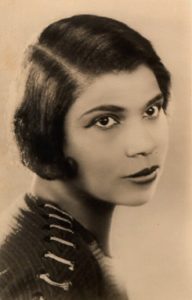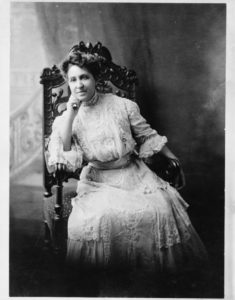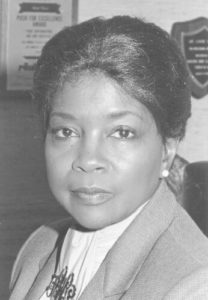Combating Racism – Honoring Women’s History Month – Part 4
This week’s newsletter honors four more noteworthy Black women—civil rights activists, a lawyer, and a labor leader—whose contributions to our society and our culture deserve being honored, especially during Women’s History Month.
MARY ELLEN PLEASANT ( ? – 1904)

Courtesy of the Napa County Historical Society
Mary Ellen Pleasant’s exact origins are fuzzy as she gave contradictory stories about her early life. In one story, she began her life as a slave in 1817, born to a Voodoo priestess and the son of a Virginia governor. In another, she was born in August 1814 in free Philadelphia to a Black mother from Louisiana and a Hawaiian silk importer father. A third version states she was born at an Augusta Georgia plantation to her enslaved mother and White plantation-owner father. We do know that she was indentured early in life to a Nantucket shopkeeper from whom she learned the basics of running a business. She also learned about the abolitionist movement, since the shopkeeper’s family were diehard abolitionists. A marriage to a wealthy free landowner named J.J. Smith, who was also an abolitionist, both solidified her fortune and advanced the cause. The Smiths worked to help slaves escape to the North and funded abolitionist causes including, it is said, John Brown’s raid on Harper’s Ferry.
After Pleasant’s husband died young, she headed west to San Francisco, which at the time was an almost lawless town. She worked as a cook and servant in rich people’s homes until she was able to start her own boardinghouse, which would be the first of many. Pleasant was a familiar fixture in the houses of the wealthy during the period of the Gold Rush, as were the servants she began to train and place there, and it’s said that she used the information she gained from her proximity to wealth to increase her own assets. She cannily invested her money and soon amassed a startling personal fortune based on stocks, real estate, and a series of businesses (including laundries and food establishments) that made her one of the growing city’s major entrepreneurs. At her peak, she was estimated to be worth $30 million dollars, an astonishing sum for the period.
As Pleasant became a powerful woman, she continued her work for civil rights, often in the courts. Shortly after the Civil War, she sued one streetcar company for not allowing Black people on their line and sued another that permitted segregation. She won both cases. She became known in the Black community for her philanthropy and very public support for civil rights, which was unusual for a woman and doubly unusual for a woman of color. She used her money to defend wronged Black people and spent thousands in legal fees, becoming a hero to a generation of Blacks in California.
Unfortunately, Pleasant’s later life was tough. She supported the case of a woman engaged in a marriage dispute with a senator from Nevada, which hurt her financially and politically when the woman lost. The death of her financial partner Thomas Bell threw her affairs into turmoil, and his widow challenged Pleasant’s right to most of her holdings. Yellow journalists branded her “Mammy Pleasant,” accusing her of everything from murdering Thomas Bell to putting entire households under voodoo spells (Pleasant, it is said, once maintained a friendship with New Orleans voodoo queen Marie LaVeau). Pleasant’s vast fortune was lost and she died in poverty in 1904. Fortunately, her sullied reputation as “Mammy” has not defined her life; today, she is more commonly remembered as “The Mother of Civil Rights in California.”
CHARLOTTE E. RAY (1850 – 1911)

Charlotte E. Ray was the first Black woman lawyer in the United States and the first woman to practice law in Washington, D.C.
Ray was born in January, 1850 in New York City. Her father, a prominent abolitionist, Charles Bennett Ray, worked as a pastor of the Bethesda Congregational Church and as editor of one of the first newspapers published by and for African Americans, The Colored American.
Ray attended one of the few schools in the country that educated Black girls: Myrtilla Miner’s Institution for the Education of Colored Youth in Washington, D.C., subsequently known as the Miner Normal School. She graduated in 1869.
That same year Ray began teaching at Howard University, just two years after the school was established, and she was accepted to the Howard School of Law where she attended classes in the evenings. She graduated with her Howard Law degree on February 27, 1872, as its first woman graduate.
Although women were not members of the bar of the District of Columbia, Ray apparently took her bar exams and applied as “C.E. Ray” securing her admission to the bar without disclosing that she was a woman, thereby becoming the first female member of the District of Columbia bar.
In 1872 Ray opened her own law practice specializing in commercial law in Washington D.C. One of her most recognized cases was her representation of Martha Gadley, a Black woman who petitioned for divorce from an abusive husband. Gadley’s petition was denied in 1875, but Ray agreed to take the case on appeal to the District of Columbia’s Supreme Court. She successfully overturned the lower court’s ruling by arguing that the husband’s habitual drunkenness and extreme violence endangered his wife’s life and entitled her to a divorce.
Despite her success, racial prejudices proved too strong. Ray was unable to obtain sufficient cases for representation, so she subsequently closed her practice in 1879 and returned to New York City to work as a teacher in the Brooklyn public school system. She was an active advocate for social justice. She attended the National Woman Suffrage Association’s (NWSA) annual convention in New York City in 1876 and she joined the National Association of Colored Women (NACW) in 1895. In 1897 she relocated to Woodside in Queens, where she lived until her death four years later at the age of 60.
Ray’s contributions to the practice of law continue well after her death. There are at least two annual awards made in her name: The Annual Charlotte E. Ray Award from the Greater Washington Area Chapter of the Women Lawyers Division of the National Bar Association and the MCCA Charlotte E. Ray Award, presented to a woman lawyer for her exceptional achievements in the legal profession and extraordinary contribution to the advancement of women in the profession.
MARY CHURCH TERRELL (1863 – 1954)

Stock Montage via Getty Images
Mary Eliza Church was a well-known African American activist who championed racial equality and women’s suffrage in the late 19th and early 20th century. The daughter of former slaves, Mary Eliza Church Terrell was born on September 23, 1863 in Memphis, Tennessee. Her father, Robert Reed Church, was a successful businessman who became one of the South’s first African American millionaires. Her mother, Louisa Ayres Church, owned a hair salon. The family was part of the rising Black middle and upper class who used their position to fight racial discrimination.
Terrell’s parents divorced during her childhood. Their affluence and belief in the importance of education enabled Terrell to attend the Antioch College laboratory school in Ohio. She later attended Oberlin College, where she earned both bachelor’s and master’s degrees, making her one of the first Black American women to be awarded a college degree.
Terrell spent two years teaching at Wilburforce College before moving to Washington DC, in 1887 to teach at the M Street Colored High School. There she met, and in 1891, married Heberton Terrell, also a teacher.
Her activism was sparked in 1892, when an old friend, Thomas Moss, was lynched in Memphis by Whites because his business competed with theirs. Although Terrell joined Ida B. Wells-Barnett in anti-lynching campaigns, her life work focused on the notion of racial uplift, the belief that Blacks would help end racial discrimination by advancing themselves and other members of the race through education, work, and community activism. It was a strategy based on the power of equal opportunities to advance the race and her belief that as one succeeds, the whole race would be elevated. Her words—“Lifting as we climb”—became the motto of the National Association of Colored Women (NACW), the group she helped found in 1896. She served as NACW president from 1896 to 1901.
As NACW president, Terrell campaigned tirelessly among Black organizations and mainstream White organizations, writing and speaking extensively. She also actively embraced women’s suffrage, which she saw as essential to elevating the status of Black women, and consequently, the entire race. She actively campaigned for Black women’s suffrage. She even picketed the Wilson White House with members of the National Woman’s Party in her zeal for woman suffrage. Terrell fought for woman suffrage and civil rights because she realized that she belonged “to the only group in this country that has two such huge obstacles to surmount…both sex and race.”
In 1909, Terrell was among the founders and charter members of the National Association for the Advancement of Colored People (NAACP). Then in 1910, she co-founded the College Alumnae Club, later renamed the National Association of University Women.
Following the passage of the 19th amendment, Terrell focused on broader civil rights. In 1940, she published her autobiography, A Colored Woman in a White World, outlining her experiences with discrimination. In 1948, Terrell became the first Black member of the American Association of University Women, after winning an anti-discrimination lawsuit. In 1950, at age 86, she challenged segregation in public places by protesting the John R. Thompson Restaurant in Washington, DC. She was victorious when, in 1953, the Supreme Court ruled that segregated eating facilities were unconstitutional, a major breakthrough in the civil rights movement.
Terrell died four years later in Highland Beach, Maryland.
REV. ADDIE WYATT (1925 – 2012)

Addie L. Wyatt (then Cameron) was born on March 8, 1924, in Brookhaven, Mississippi. As the oldest girl of eight children, Addie took care of her seven siblings while her mother Maggie Cameron worked. Rev. Wyatt credits her mother with instilling in her empathy and a sense of responsibility for others.
When Wyatt was only three, she gave her first recitation in church. This began a career in public speaking which reached through religion to human rights.
Having moved to Chicago from Mississippi at age 17, Wyatt began working at Armour & Co, a slaughterhouse and meatpacking plant. While she was originally hired over the phone as a typist, when she arrived, she was sent to the meatpacking plant because the company did not employ Black typists. This blatant act of racism had a beneficial consequence for Wyatt. She soon found herself working on the production line packing stew, a union position that paid $24.80 per week, a higher rate than typists were paid.
Like many Black women of this period, Wyatt’s first encounter with trade unionism came during World War II. She began working for the Amalgamated Meat Cutters and Butcher Workmen of North America in 1941 in Chicago and became president of the local union—the first female to hold such a position.
In 1952, she joined the United Packinghouse Workers of America (UPWA). Formerly known as the Packinghouse Workers Organizing Committee, this union formed in 1943 as part of the Congress of Industrial Organizations (CIO) and had built a reputation for militancy and advocacy of racial and gender equality.
After being asked to be a local delegate at an anti-discrimination conference, she became an activist dedicated to bringing women and people of color to the forefront of union leadership. By 1953, she was elected vice president of UPWA Local 56, and the following year, she took over the Local after the president resigned, becoming the first Black woman to hold senior office in an American labor union.
She then ran for the Executive Board of the UPWA on a platform emphasizing women’s right and the advancement of racial minorities. Soon after, Wyatt was appointed to the international staff of the UPWA as Secretary of the Civil Rights Committee.
She became an ordained minister in 1955 and the next year she and her husband Rev. Claude S. Wyatt founded the Vernon Park Church of God in Chicago. The church has approximately 1,000 members and is widely known for its work with homeless people, seniors and youth.
Wyatt’s activism was not confined to the labor movement. She had met the Reverend Martin Luther King, Jr. a few months prior to the start of the Montgomery bus boycott and then dedicated herself to the larger civil rights movement. Soon, she began working as labor liaison to King’s Southern Christian Leadership Conference (SCLC). From 1956 to 1968 she joined Dr. King in major civil rights marches, including the March on Washington, and the march from Selma to Montgomery, Alabama.
She traveled the country petitioning packinghouse workers in support of King’s campaign to end racial segregation. In 1962, Wyatt and her husband worked with Rev. Jesse Jackson to found Operation Breadbasket, which distributed food to underprivileged people in 12 American cities, and later she became involved in its successor, P.U.S.H. (People United to Serve Humanity).
Wyatt was also a vocal and active supporter for women’s rights. In 1961, she was appointed by Eleanor Roosevelt to serve on President Kennedy’s Commission on the Status of Women. She campaigned tirelessly for the passing of the Equal Rights Amendment and was the founding member of the National Organization of Women (NOW). Later, Wyatt helped to form the Coalition of Labor Union Women.
In 1974, after the UPWA merged with the Amalgamated Meat Cutters and Butcher Workmen of North America (AMCBW), she became the director of the Women’s Affairs and Human Rights Department. Her successful leadership of that department led Eleanor Roosevelt to appoint her to serve on the Labor Legislation Committee of the Commission on the Status of Women in the early 1960s. Also in 1974, Rev. Wyatt became one of the founders of the Coalition of Labor Union Women (CLUW), the country’s only national organization for union women.
Two years later, she became the first female international vice president in the history of the AMCBW. After the Amalgamated Meat Cutters union merged with the Retail Clerks union in 1979, forming the United Food and Commercial Workers (UFCW), she served as the Director of Civil Rights and Women’s Affairs until she retired in 1984. Twenty-one years later, at the age of 81, she was inducted into the Civil Rights Walk of Fame.
In 1975, with the politician Barbara Jordan, she was the first African-American woman named by Time magazine as Person of the Year and received a similar honor from The Ladies Home Journal in 1977. Ebony named her one of the 100 most influential Black Americans from 1980 to 1984. In 1987, the Coalition of Black Trade Unionists established the Addie L. Wyatt Award.
Rev. Annie Wyatt dedicated her entire life not only to the cause of labor, but also to racial and gender equality. She passed away on March 28, 2012. While there are many labor leaders who have helped pave the way for the labor movement, there are few who have ensured, as much as Addie Wyatt, that the path is broad enough to include everyone, regardless of race or gender. And though her name might not be as recognizable as others, it is only because she chose to act as a lighthouse rather than basking in the spotlight.
~ ~ ~ ~ ~ ~ ~ ~ ~ ~ ~ ~ ~ ~ ~ ~ ~ ~ ~ ~ ~ ~ ~ ~ ~ ~ ~ ~ ~ ~
Next week I will close Women’s History Month by sharing the biographies of four contemporary Black Women who have blazed trails for other women of all races.
~ ~ ~ ~ ~ ~ ~ ~ ~ ~ ~ ~ ~ ~ ~ ~ ~ ~ ~ ~ ~ ~ ~ ~ ~ ~ ~ ~ ~ ~
I’m excited to share the news: my memoir, A Daughter’s Kaddish: My Year of Grief, Devotion, and Healing will be published this fall by Wonderwell Publishing. Watch for more information to come.